Markets
BITO: Bitcoin Bear Market Begins As Excess Liquidity Dries Up (NYSEARCA:BITO)

Eoneren
One of the first articles I published this year was “BITO: 2024 May Be Bitcoin’s ‘Make Or Break’ Year.” At that time, I was bearish on the popular Bitcoin Strategy ETF (NYSEARCA:BITO) due to what I perceived as a potential top to the cryptocurrency bull market. I also believe that BITO’s risks were slightly elevated because of its exposure to liquidity risk factors in the Bitcoin futures market.
BITO has declined by ~10% since then, although its total return is positive due to its capital distribution. Bitcoin is still up 30% YTD but has lost around 17% of its value over the past month, with BITO falling by 23%. It is worth pointing out that I was not so bearish on BITO that I saw it as a short opportunity. As I stated,
I would not short Bitcoin or BITO because it could quickly rise higher over the coming months due to decent speculative momentum.
This view has primarily proven accurate. Bitcoin and BITO initially continued to climb over the spring months and have reversed those gains. That said, Bitcoin is still higher than when I became bearish on it. Thus, I think it is more reasonable to consider whether or not it may be a good time to short Bitcoin or BITO. Of course, other factors could still prove bullish for Bitcoin, so I aim to reconsider both the positive and negative arguments surrounding BITO to provide an updated outlook on the fund and its underlying asset.
Why Bitcoin and BITO Have Likely Peaked
My dominant view is that Bitcoin and most cryptocurrencies have reached a cyclical peak. It is worth stating outright that my views on Bitcoin are predicated on my fundamental belief that it is a speculative vehicle and not a viable currency. Those curious regarding my specific views may benefit from reading my recent article on the Bitcoin “miner” Riot Platforms (RIOT), “Riot Platforms: A Cash-Burning Machine, Even In The Crypto Bull Market.“
To summarize, I believe Bitcoin’s energy transaction cost and time length are magnitudes too high to make it remotely viable as a currency. That is not to say cryptocurrencies may not have viability, but that Bitcoin is likely akin to a dinosaur. It is based on a very outdated technological framework compared to more recent innovations like XRP or XMR that have superior transaction times and greater privacy abilities (particularly with XMR), as well as lack the extremely power-intensive platform such as used by Bitcoin miners like Riot. For example, while some of Texas is seeing its grid fail due to the hurricane, Riot may be using GW of power to mine an increasingly small amount of Bitcoin.
To me, issues such as that are potential catalysts that could lead to the gradual or rapid disbelief in Bitcoin. BITO is based on Bitcoin, which, in turn, is powered by speculative activity and, in my view, misfocused hope. Bitcoin and BITO are also poor hedges, with BITO being positively correlated to stocks and bonds based on monthly total returns of the S&P 500 ETF (SPY) and the Bond market ETF (BND). See below:
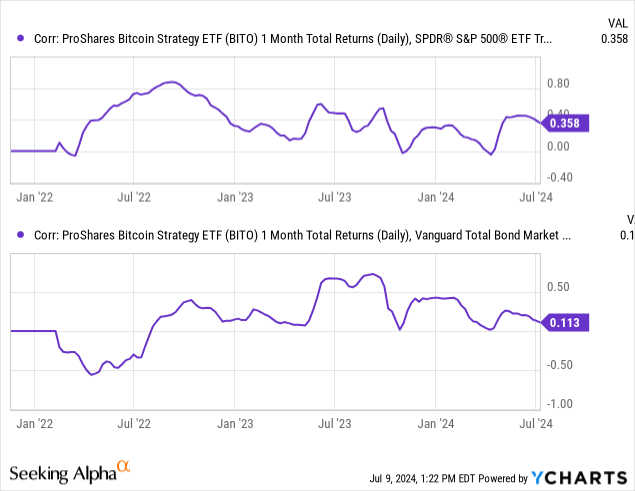 Data by YCharts
Data by YCharts
Many see Bitcoin and BITO as hedges against financial market risk. For the most part, that is not true, as Bitcoin will usually rise and fall with stocks and, to a lesser extent, bonds. Notably, although its bond correlation is never very high, it is almost never negative, implying that it is potentially not an inflation hedge (given bonds are negatively exposed to inflation).
On a shorter-term basis, BITO is not so highly correlated to stocks and bonds that investors may notice. Indeed, some exposure to BITO would reduce overall portfolio volatility on a day-to-day basis, given its correlation is usually below 0.5. However, during market crashes, or periods of considerable volatility, it is often the case that correlations rise, causing exposure to increase when it is most problematic. For example, during the summer of 2022, which saw an increased interest rate outlook amid inflation concerns, we saw notable declines in Bitcoin, which was well-mirrored in the S&P 500 and bond market. See below:
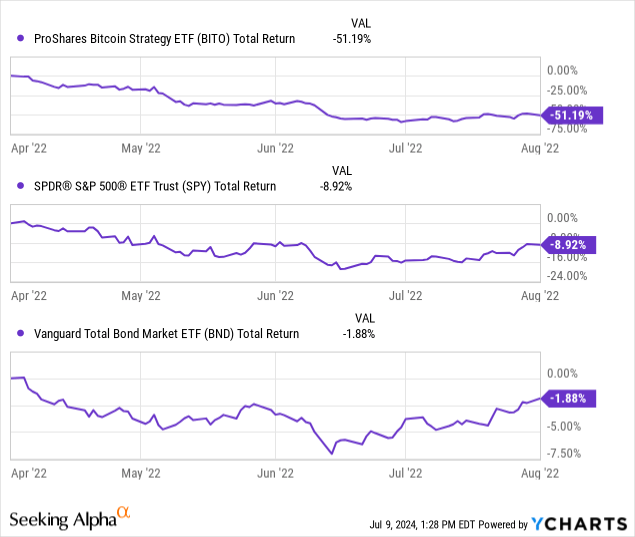 Data by YCharts
Data by YCharts
Of course, this is just one example, but investors may want to remember it. During low volatility periods, it may seem that BITO and Bitcoin are not highly exposed to general market risk. However, when volatility increases, and people are looking to sell virtually anything, Bitcoin seems to be among the things people wish to sell. Again, that implies that it is a speculative asset, not a hedge, and may crash during a period of negative stock or bond market activity.
Indeed, the recent declines in Bitcoin, mirrored in BITO, potentially indicate an increase in general financial market risk. Those who’ve read my articles likely know that I see markets as primarily liquidity-driven (cash, bank lending, Fed QE/QT) and secondarily driven by fundamentals (earnings, economy, etc.) Over recent years, most aspects of the US and global economy have stagnated, with some growing (technology) and other sectors declining (manufacturing). Still, most stocks, huge technology stocks have seen their best performance. To me, that is because the financial system has had excess liquidity coming out of the COVID stimulus and QE efforts, most of which are now burned up amid QT.
This pattern is mirrored by the relationship between Bitcoin, BITO, and individual investor cash allocations. For example, as rates were rising in 2022, many individual investors flocked to cash to take advantage of higher rates and reduce exposure to the usual economic risk that comes from higher rates. We saw Bitcoin crash during that “negative individual investor liquidity” period. However, that led to a buildup in cash allocations, which have since been redeployed into (in my view) primarily speculative assets from those looking for abnormal short-term gains. No surprise, Bitcoin and BITO have likely been among those. See below:
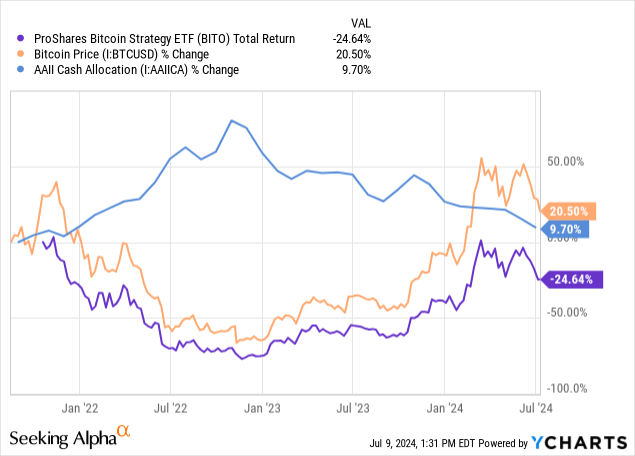
Note that this shows the change in cash allocations from the baseline. The average individual investor cash allocation level from AAII surveys is 15% today, which is the typical cyclical minimum. Usually, when cash allocations are this low, markets tend to decline or stagnate as there is insufficient sideline cash to deploy.
Many broader economic and monetary factors point to less liquidity for speculative instruments. Of course, the Fed is effectively “deleting” money through its slow QT program, bank deposits are stuck (capping lending), and personal household savings are very low (due to rising living costs). Thus, the potential sideline cash that could be deployed into Bitcoin is far lower than it has been over most of the past two years or perhaps even in Bitcoin’s history (until recently, during periods of extreme money supply growth). The only area of decent liquidity is foreign banks with US cash. I suspect that is due to more significant monetary issues in countries like Japan. However, I do not believe the potential return of overseas US dollars is sufficient to improve the overall US financial market liquidity decline.
When investors treat cash as valuable during periods of lower liquidity, we usually see overvalued financial assets decline. Conversely, periods of low interest rates or excess liquidity growth often cause some financial assets to become overvalued. From that view, I believe Bitcoin has been an area where investors with extra cash have speculatively deployed money and will thus withdraw that money first as liquidity falls back into short supply.
Although the Fed may cut rates, that will likely require a continued rise in unemployment. I believe there is very strong evidence to suggest that we’re seeing the beginnings of a much larger increase in unemployment. To me, the liquidity demands of higher unemployment would be far greater than any added supply from rate cuts. However, a return of QE could provide enough liquidity that Bitcoin and BITO may benefit. That said, I suspect that we will not see QE return until/unless stocks, bonds, and Bitcoin are far lower.
Does BITO Face Added Liquidity Risk?
Previously, one issue I saw with BITO was its exposure to the Bitcoin futures market. As I discussed, BITO owns most of the Bitcoin futures market, so if Bitcoin crashes, there may not be sufficient counterparties to the ETF. One issue is that it may have poor tax exposure because it has to occasionally sell futures and realize gains, distributing them as a cash payment. Again, BITO does not have a 41% yield, as that “yield” represents the distribution of its gains on futures, which are likely to be taxed at the short-term rate because the holding period will generally be low.
Those curious should research this issue, though that is what I surmise based on the research of others. However, from an overall efficiency standpoint, I am sure that owning Bitcoin outright is the best option for taxation issues (given your holding period is over a year), counterparty liquidity, and avoidance of BITO’s 95 bps expense ratio.
BITO’s potential counterparty liquidity issues were highlighted recently as its premium shot up during increased Bitcoin volatility. See below:
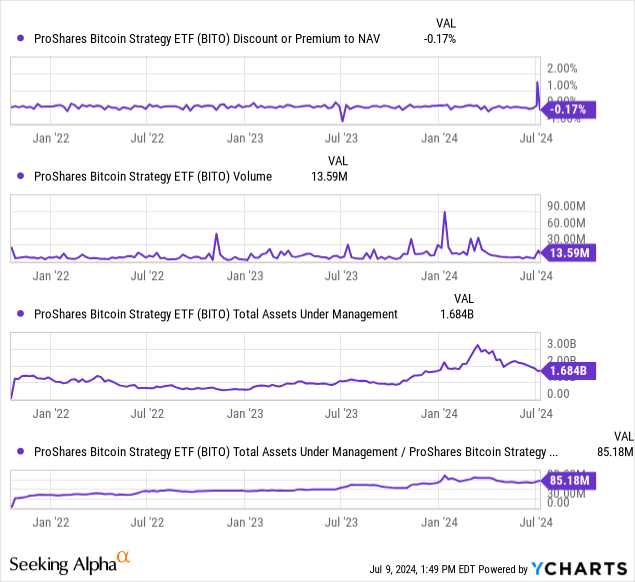 Data by YCharts
Data by YCharts
Realistically, the counterpart risk to BITO is a short-term problem. It may be that if you’re looking to sell BITO during a crash (the same day or the same week), there is a chance that BITO has an odd premium or discount that could be pretty large. To me, this risk is higher today because BITO has become very popular, as seen in its outstanding share (measured by AUM/price in the lowest chart). Again, BITO should always settle very close to Bitcoin’s spot price, but I would not want to sell the fund during a period where many others are as well since that is likelier to see a greater spread between its NAV and price. Still, that spread could be positive, potentially making it a benefit.
The Bottom Line
Overall, I downgrade my view on BITO from bearish to very bearish, with my expectation that Bitcoin has reached a cyclical peak and is becoming more firm. Since January, we’ve seen the necessary continued deterioration in total financial market liquidity drivers, such that there is insufficient “sideline cash” for Bitcoin to continue to rise.
Again, while I like some cryptocurrencies, I see zero fundamental value to Bitcoin and believe it is a waste of increasingly scarce electricity resources. So then, for me, Bitcoin relies on the “Greater Fool Theory.” In other words, I think having a bullish view of Bitcoin is entirely valid if you feel it may rise due to speculative momentum. However, considering its fundamentals as a cryptocurrency, its correlations with other asset classes, and market liquidity, it is, to me, very clear that it is only driven by excess liquidity. BITO is where you park money you don’t need, hoping it may rise, but not an investment that causes proper (economic) capital growth, as seen in most stocks.
To that end, I think BITO should decline at a faster pace because I believe financial market excess liquidity is drying up much faster and could evaporate if we see a large upward swing to unemployment. If the Fed is swift to cut rates and pursue QE, Bitcoin may stand to benefit. Of course, the Fed is, in my view, almost always too late. However, I expect that gold and silver (in particular) would benefit the most in that scenario. It is worth pointing out that silver and gold may also decline during market shocks, but not likely to the same extent as Bitcoin, which behaves more similarly to the stock market than the physical commodities.
Would I short BITO or Bitcoin today? Perhaps, but not necessarily. Over the first half of 2024, I’ve shifted from the view that “Bitcoin may peak soon” to “Bitcoin has likely peaked.” To me, it remains unclear how considerable Bitcoin’s overall downside is. I feel that Bitcoin may be due for a record decline because many may need to sell it if unemployment spikes in a traditional recession. Bitcoin remains untested in a conventional recession, given the 2020 recession was driven by external circumstances and was met with extreme liquidity stimulus.
I guess that Bitcoin may perceptively become “BitCon” as in a “con” in a 2000-like market crash, but that is speculative. Personally, I am not going to place a short on my guesses, as I feel there are other assets where short-selling is less risky. So, I may bet against BITO today. However, I would only do so with a small allocation since its downside is unclear. We could still see a resurgence in bullish speculative activity. However, I believe the odds of that are increasingly low.
Lastly, it may be that my belief that Bitcoin has no value as an alternative to fiat currency is proven incorrect. Still, again, in a world where electricity and energy prices are rising, I cannot see how Bitcoin could be a long-term viable currency alternative where many cryptocurrencies do not require so much energy per transaction.
Markets
Today’s top crypto gainers and losers

Over the past 24 hours, Jupiter and JasmyCoin emerged as the top gainers among the top 100 crypto assets, while Bittensor and Mantra plunged as the top losers.
Top Winners
Jupiter
Jupiter (JUP) led the charge among the biggest gainers on July 27.
At the time of writing, the crypto asset had surged 12.6% in the past 24 hours and was trading at $1.16. JUP’s daily trading volume was hovering around $282 million, according to data from crypto.news.
JUP Hourly Price Chart, July 26-27 | Source: crypto.news
Additionally, the cryptocurrency’s market cap stood at $1.56 billion, making it the 62nd largest crypto asset, according to CoinGecko. Despite the recent price surge, the token is still down 42.6% from its all-time high of $2 reached on Jan. 31.
Jupiter functions as a decentralized exchange aggregator that allows users to trade Solana-based tokens. The platform also offers users the best routes for direct trades between multiple exchanges and liquidity pools.
In addition to being a DEX aggregator, Jupiter has expanded into a “full stack ecosystem” by launching several new projects, including a dedicated pool to support perpetual trading and plans for a stablecoin.
JasmyCoin
JasmyCoin (JASMI) has increased by 12% in the last 24 hours and is trading at $0.0328 at press time. JASMY’s daily trading volume has increased by 10% in the last 24 hours, reaching $146 million.
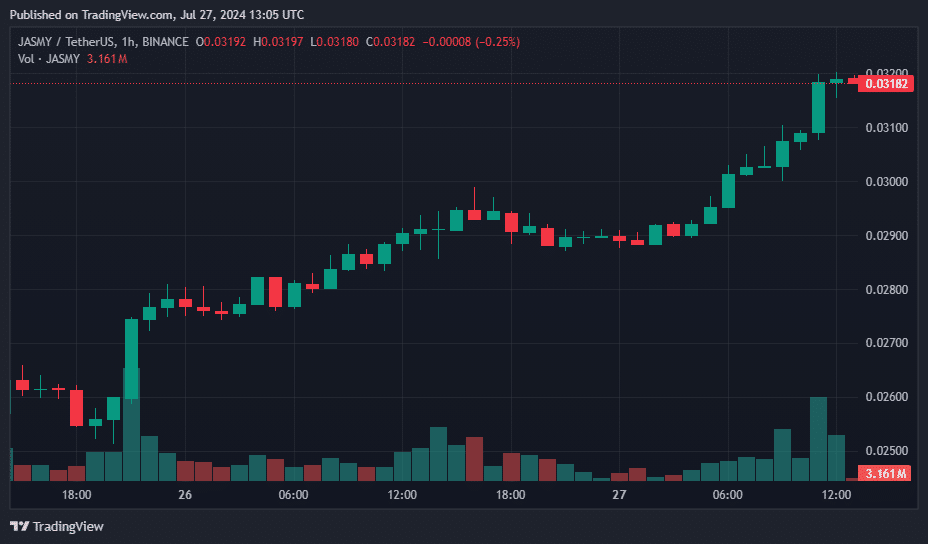
JASMY Hourly Price Chart, July 26-27 | Source: crypto.news
The asset’s market cap has surpassed the $1.5 billion mark, making it the 60th largest cryptocurrency at the time of reporting. However, the self-proclaimed “Bitcoin of Japan” is still down 99.3% from its all-time high of $4.79 on February 16, 2021.
JASMY is the native token of Jasmy Corporation, a Japanese Internet of Things provider. The platform seeks to merge the decentralization of blockchain technology with IoT, allowing users to convert their digital information into digital assets.
The initiative was launched by Kunitake Ando, former COO of Sony Corporation, along with Kazumasa Sato, former CEO of Sony Style.com Japan Inc., Hiroshi Harada, executive financial analyst at KPMG, and other senior executives from Japan.
Kaspa
Kaspa (KAS) saw a 100% increase in trading volume and an 8% increase in price over the past 24 hours, trading at $0.19 at the time of publication.
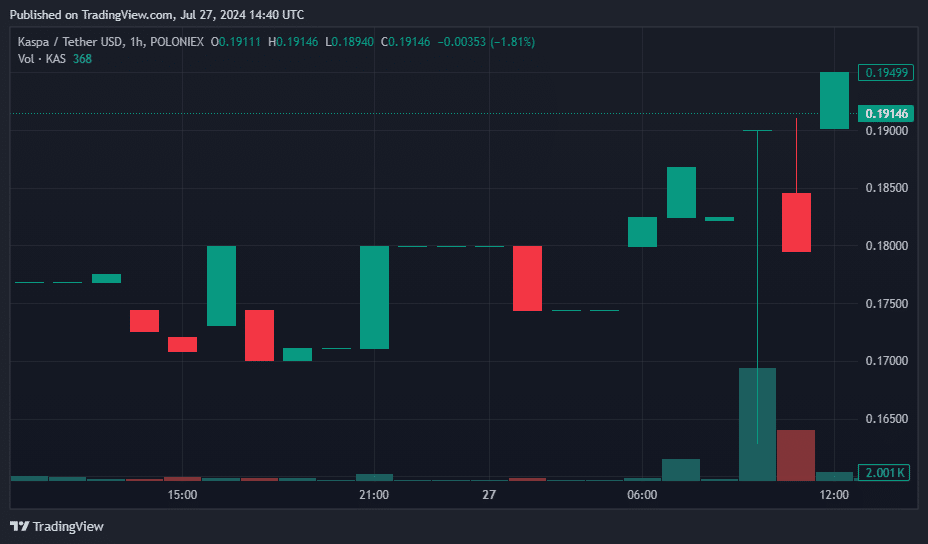
KAS Hourly Price Chart, July 26-27 | Source: crypto.news
According to data from CoinGecko, Kaspa now ranks 27th in the global cryptocurrency list, with a circulating supply of approximately 24.29 billion KAS tokens and a market capitalization of $4.59 billion.
Kaspa is a cryptocurrency designed to deliver a high-performance, scalable, and secure blockchain platform. Its unique Layer-1 protocol includes the GhostDAG protocol, a proof-of-work (PoW) consensus mechanism that enables faster block times and higher transaction throughput compared to standard blockchains.
Unlike Bitcoin, GhostDAG allows multiple blocks to be created simultaneously, speeding up transactions and increasing block rewards for miners.
Bonk
Bonk (BONK) is the only one coin meme which made it to this list of biggest gainers and jumped 8.6% in the last 24 hours. Trading at $0.000030, the Solana-based meme coin’s market cap has surpassed $2.1 billion, surpassing Floki (FLOKI), another competing dog-themed coin with a market cap of $1.78 billion.
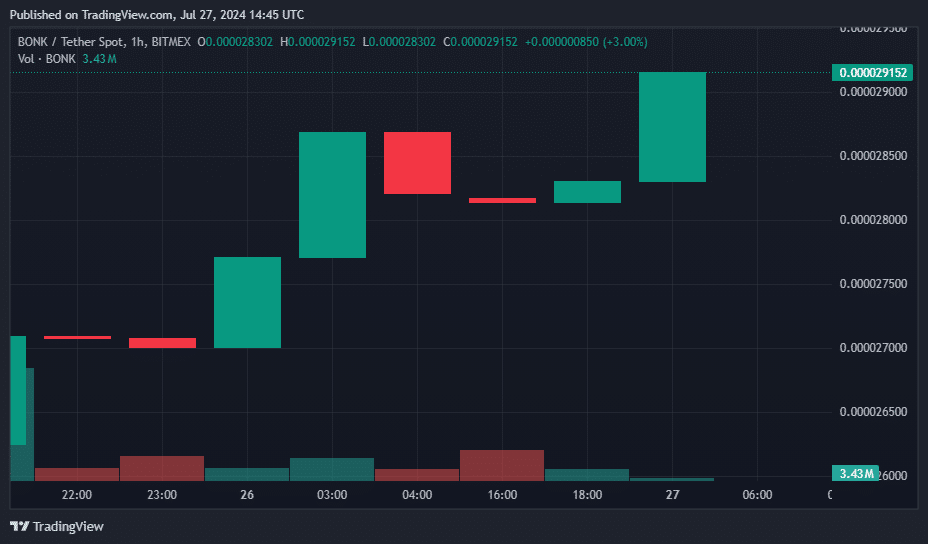
BONK Hourly Price Chart, July 26-27 | Source: crypto.news
BONK’s daily trading volume hovered around $285 million. However, BONK is still down 33.5% from its all-time high of $0.000045, reached on March 4.
Bonk, a meme coin that rose to prominence in 2023, has contributed significantly to Solana’s value increase amid the meme coin frenzy.
Bonk started out as a simple dog-themed coin. It has since expanded its features to include integration with decentralized finance. The project also partners with cross-chain communication protocols, NFT marketplaces, and various other cryptocurrency ecosystems.
BONK trading pairs are now listed on major exchanges including Binance, Coinbase, OKX, and Bitstamp.
The big losers
Bittensor
Bittensor (TAO) was the biggest loser among the 100 largest crypto assets, according to data from CoinGecko.
At the time of writing, TAO, the native token of decentralized AI project Bittensor, was down 5%, trading around $344. The crypto asset had a daily trading volume of $59 million and a market cap of $2.43 billion.
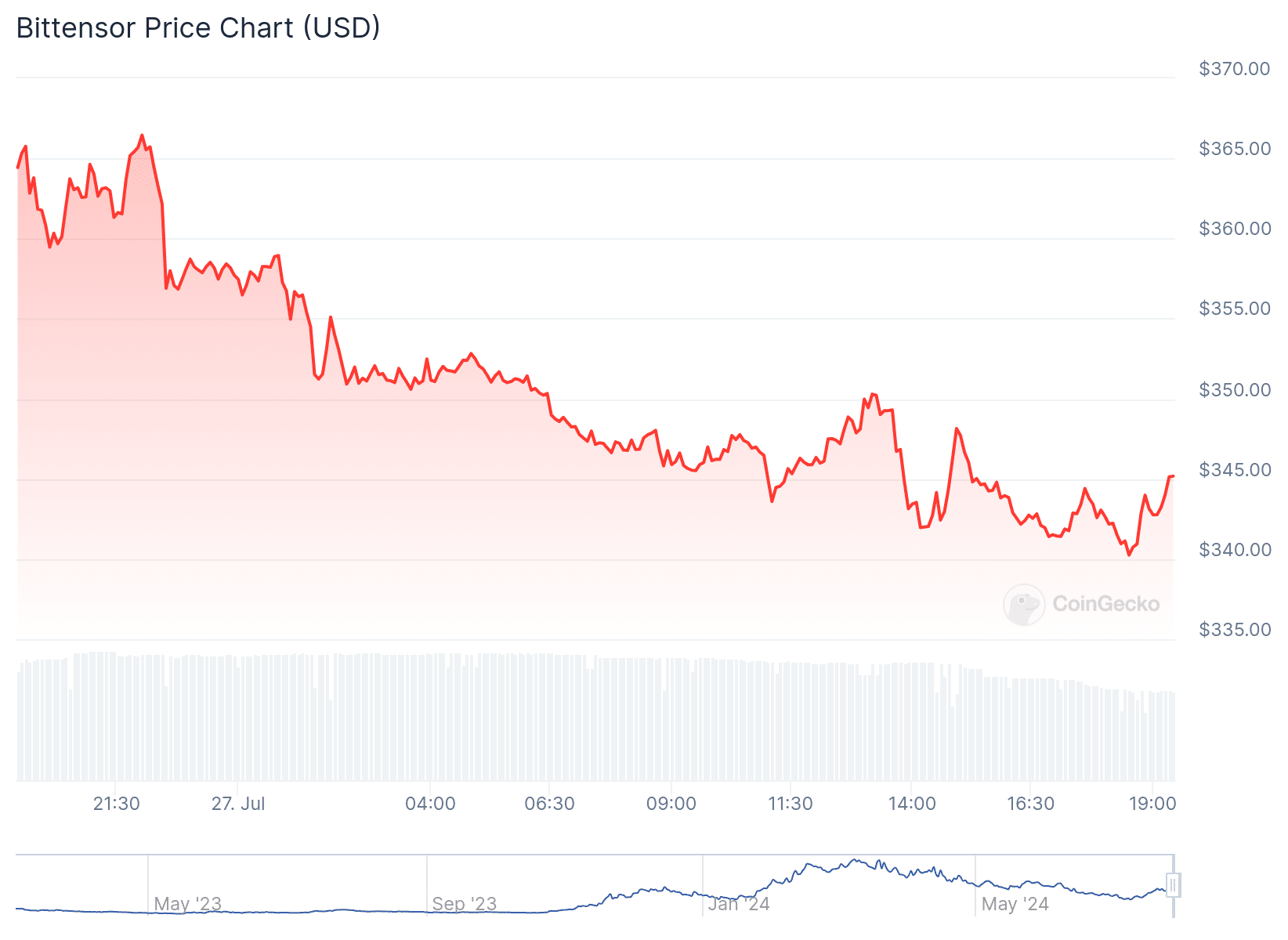
TAO 24 Hour Price Chart | Source: CoinGecko
Bittensor, created in 2019 by AI researchers Ala Shaabana and Jacob Steeves, initially operated as a parachain on Polkadot before transitioning to its own layer-1 blockchain in March 2023.
Mantra
Mantra (OM) fell 6%, trading at $1.13 at press time. The digital currency’s market cap fell to $938 million. Additionally, the 82nd largest crypto asset has a daily trading volume of $26 million.
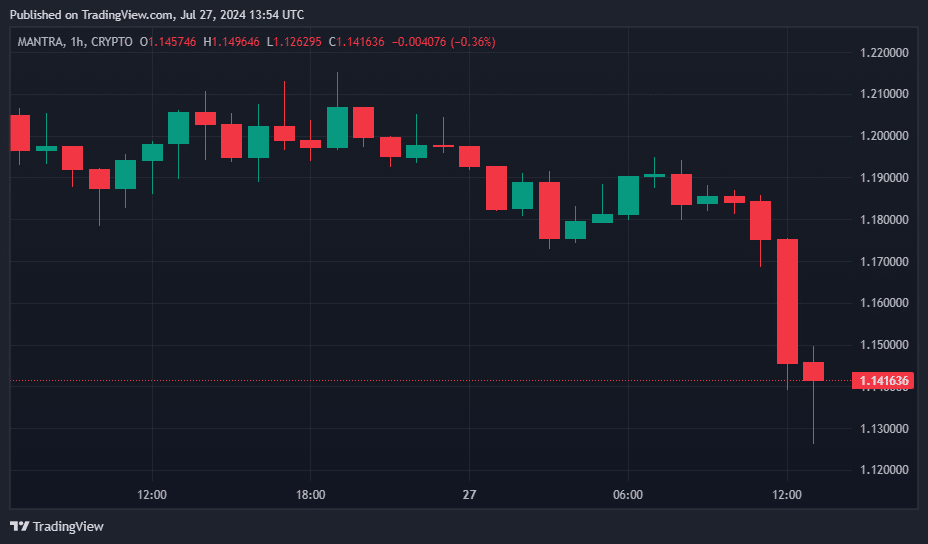
OM Price Hourly Chart, July 26-27 | Source: crypto.news
Mantra is a modular blockchain network comprising two chains, Manta Pacific and Manta Atlantic, specialized in zero-knowledge applications.
Coat
Coat (MNT) also saw a 2.4% drop in price, now trading at $0.8413. Currently, Mantle has a market cap of around $2.75 billion, which ranks 36th in the global cryptocurrency rankings by market cap, according to price data from crypto.news.
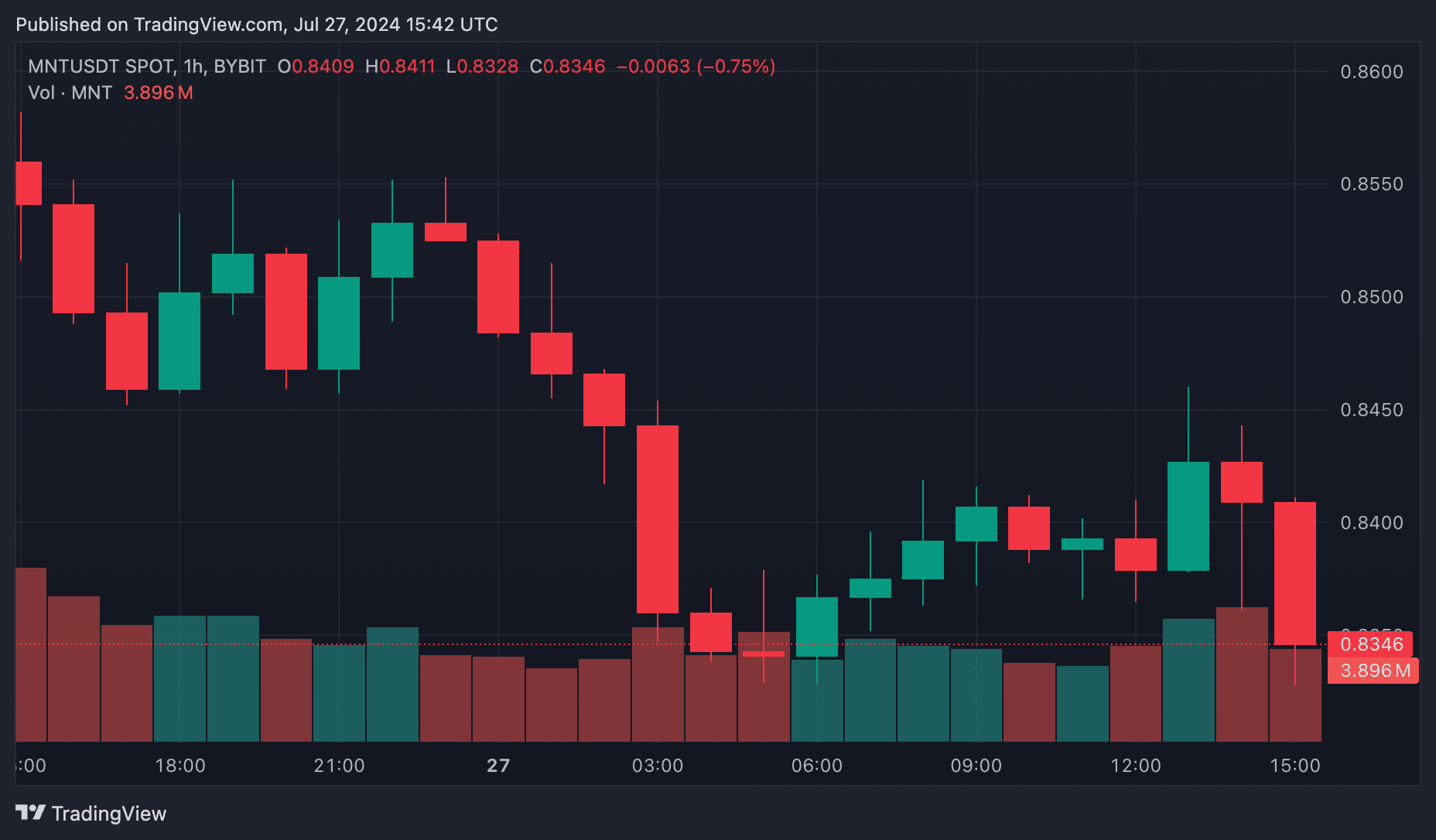
MNT Hourly Price Chart, July 26-27 | Source: crypto.news
Over the past 24 hours, MNT trading volume also fell by 6%, reaching $240 million.
Mantle, formerly known as BitDAO, is an investment DAO closely associated with Bybit. The MNT token is essential for governance, paying gas fees on the Mantle network, and staking on various platforms.
Built on the Ethereum network, Mantle provides a platform for decentralized application developers to launch their projects. It has become particularly popular for GameFi applications, leading to the formation of an internal Web3 gaming team.
Markets
Bitcoin Price Drops to $67,000 Despite Trump’s Pro-Crypto Comments, Further Correction Ahead?

Pioneer cryptocurrency Bitcoin has registered a 1.13% decline in the past 24 hours to trade at $67,400. Despite a strong pro-crypto stance from US presidential candidate Donald Trump at the Bitcoin 2024 conference, this massive selloff has raised concerns in the market about the asset’s sustainability at a higher price. However, given the recent three-week rally, a slight pullback this weekend is justifiable and necessary to regain the depleted bullish momentum.
Bitcoin Price Flag Formation Hints at Opportunity to Break Beyond $80,000
The medium-term trend Bitcoin Price remains a sideways trend amidst the formation of a bullish flag pattern. This chart pattern is defined by two descending lines that are currently shaping the price trajectory by providing dynamic resistance and support.
On July 5, BTC saw a bullish reversal from the flag pattern at $53,485, increasing its asset by 29.75% to a high of $69,400. This recent spike followed the market’s positive sentiment towards the Donald Trump speech at the Bitcoin 2024 conference in Nashville on Saturday afternoon.
Bitcoin Price | Tradingview
In his speech, Trump outlined several pro-crypto initiatives: he promised to replace SEC Chairman Gary Gensler on his first day in office, to establish a Strategic National Reserve of Bitcoin if elected, to ensure that the U.S. government holds all of its assets. Bitcoin assets and block any attempt to create a central bank digital currency (CBDC) during his presidency.
He also claimed that under his leadership, Bitcoin and cryptocurrencies will skyrocket like never before.
Despite Donald Trump’s optimistic promises, the BTC price failed to reach $70,000 and is currently trading at $67,400. As a result, Bitcoin’s market cap has dipped slightly to hover at $1.335 trillion.
However, this pullback is justified, as Bitcoin price has recently seen significant growth over the past three weeks, which has significantly improved market sentiment. Thus, price action over the weekend could replenish the depleted bullish momentum, potentially strengthening an attempt to break out from the flag pattern at $70,130.
A successful breakout will signal the continuation of the uptrend and extend the Bitcoin price forecast target at $78,000, followed by $84,000.
On the other hand, if the supply pressure on the upper trendline persists, the asset price could trigger further corrections for a few weeks or months.
Technical indicator:
- Pivot levels: The traditional pivot indicator suggests that the price pullback could see immediate support at $64,400, followed by a correction floor at $56,700.
- Moving average convergence-divergence: A bullish crossover state between the MACD (blue) and the signal (orange) ensure that the recovery dynamics are intact.
Related Articles
Frequently Asked Questions
A CBDC is a digital form of fiat currency issued and regulated by a country’s central bank. It aims to provide a digital alternative to traditional banknotes.
The proposal for a strategic national Bitcoin reserve is a major confirmation of Bitcoin’s legitimacy and potential as a reserve asset. Such a move could position Bitcoin in a similar way to gold, potentially stabilizing its price and encouraging other countries to adopt similar strategies.
Conferences like Bitcoin 2024 serve as essential platforms for networking, knowledge sharing, and showcasing new technologies within the cryptocurrency industry.
Markets
Swiss crypto bank Sygnum reports profitability after surge in first-half trading volumes – DL News

- Sygnum says it has reached profitability after increasing transaction volumes.
- The Swiss crypto bank does not disclose specific profit figures.
Sygnum, a Swiss global crypto banking group with approximately $4.5 billion in client assets, announced that it has achieved profitability after a strong first half, with key metrics showing year-to-date growth.
The company said in a Press release Compared to the same period last year, cryptocurrency spot trading volumes doubled, cryptocurrency derivatives trading increased by 500%, and lending volumes increased by 360%. The exact figures for the first half of the year were not disclosed.
Sygnum said its staking service has also grown, with the percentage of Ethereum staked by customers increasing to 42%. For institutional clients, staking Ethereum has a benefit that goes beyond the limitations of the ETF framework, which excludes staking returns, Sygnum noted.
“The approval and launch of Bitcoin and Ethereum ETFs was a turning point for the crypto industry this year, leading to a major increase in demand for trusted, regulated exposure to digital assets,” said Martin Burgherr, Chief Client Officer of Sygnum.
He added: “This is also reflected in Sygnum’s own growth, with our core business segments recording significant year-to-date growth in the first half of the year.”
Sygnum, which has also been licensed in Luxembourg since 2022, plans to expand into European and Asian markets, the statement said.
Markets
Former White House official Anthony Scaramucci says cryptocurrency bull market could be sparked by regulatory clarity

Anthony Scaramucci, founder of Skybridge Capital, says the next cryptocurrency bull market could be sparked by a new wave of clear cryptocurrency regulations.
In a new interview On CNBC’s Squawk Box, the former White House communications director said he and two other prominent industry figures traveled to Washington, D.C. to speak to officials about the dangers of Sen. Elizabeth Warren and U.S. Securities and Exchange Commission (SEC) Chairman Gary Gensler’s hardline approach to cryptocurrency regulation.
“Mark Cuban, myself, and Michael Novogratz were in Washington a few weeks ago to speak with White House officials and explain the dangers of Gary Gensler and Elizabeth Warren’s anti-crypto approach. I hope that message gets through…
“Overall, if we can get regulatory policy around Bitcoin and crypto assets in sync, we will have a bull market next year for these assets.”
Scaramucci then compares crypto assets to ride-hailing company Uber, saying regulators were initially wary of the service but eventually decided to adopt clear guidelines due to public demand.
“Remember Uber: Nobody wanted Uber. A lot of regulators didn’t want it. Mayors and deputy mayors didn’t want it, but citizens wanted Uber and eventually accepted the idea of regulating it fairly. I think we’re there now.”
The CEO also says young Democratic voters believe their leaders are making the wrong choices when it comes to digital assets.
“I think President Trump’s move toward Bitcoin and crypto assets has shaken Democrats to their core, and I think very smart, younger Democrats are recognizing that they are completely off base with their positions, completely off base with these SEC lawsuits and regulation by law enforcement, and now they need to get back to the center.”
Don’t miss a thing – Subscribe to receive email alerts directly to your inbox
Check Price action
follow us on X, Facebook And Telegram
Surf The Daily Hodl Mix
 
Disclaimer: Opinions expressed on The Daily Hodl are not investment advice. Investors should do their own due diligence before making any high-risk investments in Bitcoin, cryptocurrencies or digital assets. Please be advised that your transfers and trades are at your own risk, and any losses you may incur are your responsibility. The Daily Hodl does not recommend the buying or selling of any cryptocurrencies or digital assets, nor is The Daily Hodl an investment advisor. Please note that The Daily Hodl participates in affiliate marketing.
Image generated: Midjourney
-

 Videos4 weeks ago
Videos4 weeks agoAbsolutely massive: the next higher Bitcoin leg will shatter all expectations – Tom Lee
-

 News12 months ago
News12 months agoVolta Finance Limited – Director/PDMR Shareholding
-

 News12 months ago
News12 months agoModiv Industrial to release Q2 2024 financial results on August 6
-

 News12 months ago
News12 months agoApple to report third-quarter earnings as Wall Street eyes China sales
-

 News12 months ago
News12 months agoNumber of Americans filing for unemployment benefits hits highest level in a year
-

 News1 year ago
News1 year agoInventiva reports 2024 First Quarter Financial Information¹ and provides a corporate update
-

 News1 year ago
News1 year agoLeeds hospitals trust says finances are “critical” amid £110m deficit
-

 Markets1 year ago
Markets1 year agoWhale Investments in Bitcoin Hit $100 Billion in 2024, Fueling Insane Investor Optimism ⋆ ZyCrypto
-
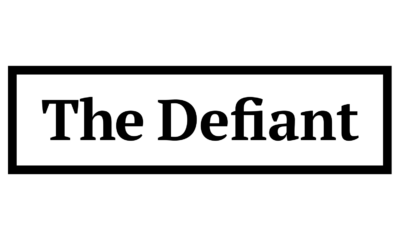
 DeFi1 year ago
DeFi1 year ago🏴☠️ Pump.Fun operated by Insider Exploit
-

 Videos1 year ago
Videos1 year ago$1,000,000 worth of BTC in 2025! Get ready for an UNPRECEDENTED PRICE EXPLOSION – Jack Mallers
-

 Videos1 year ago
Videos1 year agoABSOLUTELY HUGE: Bitcoin is poised for unabated exponential growth – Mark Yusko and Willy Woo
-

 Tech1 year ago
Tech1 year agoBlockDAG ⭐⭐⭐⭐⭐ Review: Is It the Next Big Thing in Cryptocurrency? 5 questions answered





